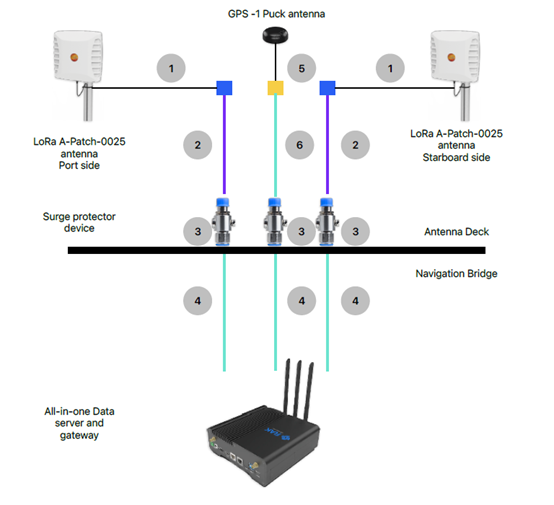Smart Bilge Monitoring: Wireless Success at Sea

Project Info:
- Customer: Vegter Condition Monitoring (Pty) Ltd
- Location: MSC Shipping
- POYNTING Product: PATCH-25
Key Article Takeaways
- Bilge Guard System: A smart, wireless bilge monitoring solution improves safety and oversight on ships.
- LoRa Technology: Uses long-range wireless communication to reduce cabling.
- Signal Challenges: Steel ship structures required stronger antennas for reliable data transmission.
- PATCH-25 Antennas: High-gain POYNTING antennas solved signal issues and simplified installation.
- Fleet Expansion: MSC plans to roll out the system fleet-wide over the next few years.
Introduction: A New Era in Bilge Monitoring
In August 2023, Vegter Condition Monitoring (Pty) Ltd embarked on an innovative project with MSC Shipping, one of the world’s largest container shipping companies. The goal? To develop and test a new wireless monitoring system for bilge wells—the low points in a ship where water can accumulate.
Their solution, now called the Bilge Guard, moves beyond traditional bilge alarms. Instead of only triggering an alert when water reaches a certain level, the system continuously measures bilge levels and relays this data to the ship’s monitoring system.
To make the system efficient and reduce complex cabling, Vegter Condition Monitoring decided to use LoRa (Long Range) wireless communication, a radio technology designed for long-distance, low-power data transmission. This would allow the bilge sensors to send data to a central server via strategically placed LoRa gateways.
The drawing shows that the distance between the bridge-mounted LoRa antenna (top left) and the Bilge Guard sensor (bottom right), positioned above the Hold 1 bilge well, is 136 m (446 ft) along the beam.

The Challenge: Wireless Communication on Steel Vessels
Steel structures, like those on container ships, severely limit wireless signal transmission. During shore-based tests, LoRa communication was promising, but onboard communication gaps quickly became apparent.
- The original 2dBi antennas on the LoRa gateways could only maintain reliable communication for about 50 metres along the port and starboard passageways.
- Signal strength would fail once the RSSI (Received Signal Strength Indicator) dropped below -125dBm, limiting the effective range. (Want to learn more about RSSI – read this)
- Installing multiple antennas along passageways would have increased complexity and maintenance.
The team needed a higher-gain, robust antenna to ensure stable communication without additional onboard infrastructure.
The Solution: POYNTING PATCH-25 Antennas
Working with INTETO CONNECT (Pty) Ltd, Vegter Condition Monitoring selected the POYNTING PATCH-25 antenna for the next phase of the project.
Why this antenna?
- Frequency: 860 – 960 MHz, perfect for LoRa applications.
- Gain: 8.8 dBi, offering a stronger and more reliable signal than the original 2 dBi antennas.
- Circular Polarisation: Improves signal performance in reflective environments like steel ships.
Instead of placing antennas along the passageways, the team mounted two PATCH-25 antennas on the bridge antenna deck (see picture below). This streamlined the installation, avoided multiple cable runs, and maintained clear communication with all LoRa gateways onboard.

Real-World Results
With operations spanning three global time zones, Seasat IT has rapidly become a trusted provider of high-performance offshore connectivity. Their clients benefit from:
- Improved crew morale and retention
- Increased operational efficiency
- Resilient, 24/7 connectivity backed by expert monitoring and support
By providing an “internet-like-home” experience while safeguarding mission-critical systems, Seasat IT’s hybrid approach delivers both performance and peace of mind.
The proof-of-concept (POC) was first installed on the MSC Kanu F, with further installations planned for the MSC Hassum III, MSC Lucia III, MSC Hanisha III, and MSC Sheffield III. Over the next 2–3 years, MSC plans to roll out the Bilge Guard system across more vessels, with POYNTING antennas powering the wireless backbone.
This diagram shows how bridge-mounted LoRa antenna communicates with the onboard sensors, enabling reliable data transmission across the vessel for monitoring and control purposes.
Customer Experience & Conclusion
This collaboration between MSC Shipping, Vegter Condition Monitoring, and INTETO CONNECT highlights how innovative wireless technology combined with the right antennas can solve real-world maritime challenges. As the project scales, the POYNTING antennas will continue to be a critical component in keeping the Bilge Guard system connected and reliable.
If you would like more information about this project, or need expert advice on selecting the right solution for your own industrial or infrastructure applications, contact Jan Otto at Inteto Connect (Pty) Ltd 📧 [email protected] or your closest POYNTING Partner.
We are ready to help you achieve reliable, high-performance wireless connectivity for your next project.


